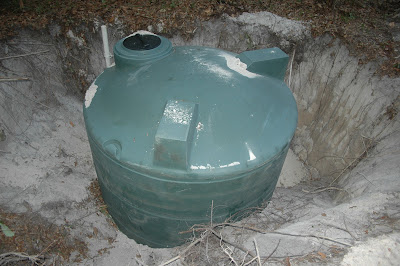If you already have a place, great, but Mrs. Quonsetman and I live in a townhouse condo, in a major metro area, on a golf course, just a stone's throw from I-95. We checked the condo documents and since they specifically prohibit Quonset huts, a new location was mandatory. Our criteria required that our new home be relatively remote, but close enough to civilization where we can get to vital services: doctors, hospitals, Costco, and a reliable hair dresser for Mrs. Q.
(Even though we're committed to a self-sustaining life-support system, there are some things you just can't ask us to live without.)
Money is always a concern, but we were able to purchase 5.64 acres of pristine wilderness in what was once a swamp just 40 years ago. It was more than we could afford, but the sacrifice is worth it.
 |
| This is our driveway |
What a view to see when coming home! It's important to have a place that supplements the essential with the aesthetic.
 |
| Paradise found |
Smack-dab in the middle of a pristine tropical forest, deer, wild hogs, turkeys, and an occasional Florida Panther have been seen meandering through this neighborhood. The trees are majestic, the land is sandy and flat, and the only access is a dead-end dirt road about a mile and a half from a paved highway. We're five miles from the nearest town which boasts two restaurants, one grocery store, one gas station, and over 100 front-yard flea markets. What more could anyone want?
 |
| Our cistern |
Having access to an ample water supply prompted us to plant this 3,000 gallon cistern to collect rainwater from the roof of our Quonset hut. When our compound is complete we will have over 3,000 square feet of water collection surfaces directing the flow of rainwater to the cistern. Overflow from the cistern will spill over into our pond, giving us total of around 50,000 gallons of water storage to support us, our gardens, and our livestock (when we decide to add them). Because we don't want to spend all our time working, our philosophy is to have every element in our homestead be completely passive in its operation.



























